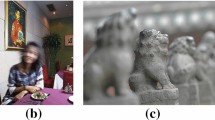Abstract
A new methodology for blur detection with multi-method fusion is presented in this paper. The research is motivated by the observation that there is no single method that can give the best performance in all situations. We try to discover the underlying performance complementary patterns of several state-of-the-art methods, then use the pattern specific to each image to get a better overall result. Specifically, a Conditional Random Filed (CRF) framework is adopted for multi-method blur detection that not only models the contribution from individual blur detection result but also the interrelation between neighbouring pixels. Considering the dependence of multi-method fusion on the specific image, we single out a subset of images similar to the input image from a training dataset and train the CRF-based multi-method fusion model only using this subset instead of the whole training dataset. The proposed multi-method fusion approach is shown to stably outperform each individual blur detection method on public blur detection benchmarks.
Access this chapter
Tax calculation will be finalised at checkout
Purchases are for personal use only
Similar content being viewed by others
References
Shi, J., Xu, L., Jia, J.: Discriminative blur detection features. In: CVPR, pp. 2965–2972 (2014)
Chakrabarti, A., Zickler, T., Freeman, W.T.: Analyzing spatially-varying blur. In: CVPR, pp. 2512–2519 (2010)
Liu, R., Li, Z., Jia, J.: Image partial blur detection and classification. In: CVPR, pp. 1–8 (2008)
Su, B., Lu, S., Tan, C.L.: Blurred image region detection and classification. In: ACMMM, pp. 1397–1400 (2011)
Lafferty, J., McCallum, A., Pereira, F.C.N.: Conditional random fields: Probabilistic models for segmenting and labeling sequence data. In: ICML, pp. 282–289 (2001)
Derpanis, K.G., Lecce, M., Daniilidis, K., Wildes, R.P.: Dynamic scene understanding: The role of orientation features in space and time in scene classification. In: CVPR, pp. 1306–1313 (2012)
Serre, T., Wolf, L., Bileschi, S., Riesenhuber, M., Poggio, T.: Robust object recognition with cortex-like mechanisms. PAMI 29(3), 411–426 (2007)
Toshev, A., Taskar, B., Daniilidis, K.: Shape-based object detection via boundary structure segmentation. IJCV 99(2), 123–146 (2012)
Levin, A.: Blind motion deblurring using image statistics. In: NIPS, pp. 841–848 (2006)
Dai, S., Wu, Y.: Removing partial blur in a single image. In: CVPR, pp. 2544–2551 (2009)
Mai, L., Niu, Y., Liu, F.: Saliency aggregation: a data-driven approach. In: CVPR, pp. 1131–1138 (2013)
Lin, H.T., Tai, Y.-W., Brown, M.S.: Motion regularization for matting motion blurred objects. PAMI 33(11), 2329–2336 (2011)
Liu, T.-J., Lin, W., Kuo, C.-C.J.: Image quality assessment using multi-method fusion. TIP 22(5), 1793–1807 (2013)
Liu, T., Yuan, Z., Sun, J., Wang, J., Zheng, N., Tang, X., Shum, H.-Y.: Learning to detect a salient object. PAMI 33(2), 353–367 (2011)
Blake, A., Rother, C., Brown, M., Perez, P., Torr, P.: Interactive image segmentation using an adaptive GMMRF model. In: Pajdla, T., Matas, J.G. (eds.) ECCV 2004. LNCS, vol. 3021, pp. 428–441. Springer, Heidelberg (2004)
Oliva, A., Torralba, A.: Modeling the shape of the scene: a holistic representation of the spatial envelope. IJCV 42(3), 145–175 (2001)
Acknowledgement
This work was supported in part by the National Science Foundation of China No. 61472103, and Key Program Grant of National Science Foundation of China No. 61133003.
Author information
Authors and Affiliations
Corresponding author
Editor information
Editors and Affiliations
Rights and permissions
Copyright information
© 2015 Springer International Publishing Switzerland
About this paper
Cite this paper
Huang, Y., Yao, H., Zhao, S. (2015). Blur Detection Using Multi-method Fusion. In: Ho, YS., Sang, J., Ro, Y., Kim, J., Wu, F. (eds) Advances in Multimedia Information Processing -- PCM 2015. PCM 2015. Lecture Notes in Computer Science(), vol 9314. Springer, Cham. https://doi.org/10.1007/978-3-319-24075-6_37
Download citation
DOI: https://doi.org/10.1007/978-3-319-24075-6_37
Published:
Publisher Name: Springer, Cham
Print ISBN: 978-3-319-24074-9
Online ISBN: 978-3-319-24075-6
eBook Packages: Computer ScienceComputer Science (R0)




